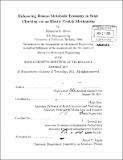Enhancing human metabolic economy in stair climbing via an elastic crutch mechanism
Author(s)
Berns, Madalyn S. (Madalyn Sarah)
DownloadFull printable version (7.989Mb)
Other Contributors
Massachusetts Institute of Technology. Dept. of Mechanical Engineering.
Advisor
Hugh Herr.
Terms of use
Metadata
Show full item recordAbstract
Crutching provides a significant increase in mobility for those with limited walking ability. While level ground walking with crutches has been studied in many different forms, stair climbing is a more energetically taxing activity and the upper arm and shoulder strength required is not always available in weaker or severely injured patients. We posit that the introduction of parallel springs spanning the elbow joint will improve the crutching experience by helping patients attain a metabolic reduction compared to unassisted locomotion. Here, we present a foundation for achieving metabolic reduction with joint-spanning elastic elements. Our approach includes three parts. First, we present an augmented crutch design with an elbow spring that can be modified with different stiffnesses. Second, we put forth a clinical testing protocol in which we measure metabolic economy via the pulmonary gas exchange technique (Vo2avg). Simultaneously recording electromyographic (EMG) signals from the primary active muscles provides a neuromuscular interpretation of the crutching activity not captured by the black-box metabolic techniques. We complete the picture by modeling the energetics of the effective elbow muscle by incorporating empirical measurements of maximum angular velocity achieved under a range of isotonic conditions. The metabolic data exhibits trends consistent with our hypothesis of metabolic reduction; although, more subjects are needed to confirm these results. All subjects reported a feeling of augmentation at the optimal stiffness condition. An analysis of the EMG results show a clear transition in muscle usage patterns from a triceps only power stroke to a combined usage of both triceps and biceps. Where the triceps are maximally active during the non-augmented state, as stiffness increases the biceps become more active and the total activation level drops, suggesting the this shift is at least partially responsible for the observed metabolic reduction. While the model correctly predicts the relative shape of the observed curve, the optimal stiffness predictions are higher than their empirical equivalents. This is most likely due to the extra help the triceps muscles received from active stabilization and power muscles not considered in the model. With a more complete muscular picture one could begin to construct an accurate method of prediction and tuning of optimal stiffness.
Description
Thesis (S.M.)--Massachusetts Institute of Technology, Dept. of Mechanical Engineering, 2011. Cataloged from PDF version of thesis. Includes bibliographical references (p. 77-79).
Date issued
2011Department
Massachusetts Institute of Technology. Department of Mechanical EngineeringPublisher
Massachusetts Institute of Technology
Keywords
Mechanical Engineering.